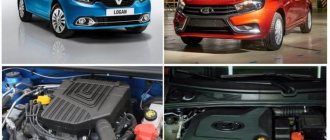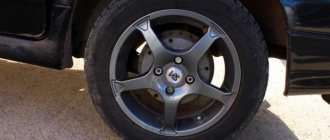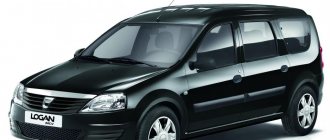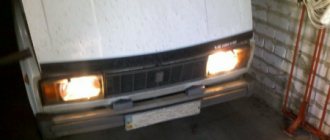Immediately after the start of sales, Lada Vesta caused a stir among motorists. Many of those who were looking for a car in the budget price segment began to consider this model in more depth. Ultimately, the majority of motorists preferred Vesta over models from foreign manufacturers, which cost more. However, after the start of sales of the Lada-X-Ray, buyers began to think about what to choose - a cheaper sedan or a roomy city hatchback. Some car enthusiasts still have not found an answer to this question. Therefore, it will be considered in more detail. We will compare Vesta and X-Ray below.
Main differences between the models
The main difference, judging by the reviews, between the Lada-Vesta and the Lada-X-Ray is that the sedan is a car developed completely from scratch. Its development lasted for quite a long period, but people started talking about Vesta already in the early stages of construction. The model is popular because people have been waiting for its appearance for a long time. With regards to X-Ray, we can say that it was not developed from scratch. The model was based on the no less famous Renault Sandero model, and it was built on the basis of the Logan, which has been tested over the years by many taxi drivers in Russia.
In this case, people get confused in their choice. They think about what is better to choose - new developments and sensations or a reliable platform that has long proven itself to be good. So far there are no exact answers to this dispute. All differences will be discussed in more detail below. Which is better - Vesta or X-Ray?
Body
Some drivers choose a car based on the prestige of a particular brand. However, in this case this factor is minimal, since both models are produced by the same company. Many people judge prestige by looking at the body; they differ between Vesta and X-Ray.
Vesta is produced only in a sedan body, but in the near future the plant is preparing to present other versions to the public: a hatchback, a station wagon, a version with increased ground clearance and a car with an extended wheelbase. The latter will be produced in limited quantities, but this version looks more prestigious than the others. Many VAZ car lovers are looking forward to these new items.
"X-Ray" is available for free sale only in the hatchback body. Some people believe that the model is a crossover, but this is not so. For fans of light off-road driving, AvtoVAZ is still preparing a version of the XRAY Cross, which can be considered a full-fledged crossover. Changes in the new product will be minimal: all-wheel drive, increased ground clearance, various body linings and other improvements.
If you like sedan cars, then it is best to choose the Lada-Vesta. If you like “pseudo-crossovers”, the size of which is slightly larger than that of other cars, then it is better to give preference to “X-Ray”. There are no suitable options for station wagon lovers at the moment, but Vesta should soon appear in this body style. The same applies to those who like crossovers for overcoming light off-road conditions. AvtoVAZ is preparing Xray Cross for them.
What is the need for comparison?
Why is it necessary to compare cars? The fact is that each of them has its own distinct pros and cons. Sometimes they appear more significantly, sometimes they are practically indistinguishable to an inexperienced driver. In some cases, the disadvantages and advantages of one model overlap with the pros and cons of another, making it impossible to choose a specific comparison winner. In other circumstances, the advantages and disadvantages are expressed more clearly, making one vehicle more preferable for use in certain conditions.
As for the comparison of Lada Vesta and Lada X-Ray, this comparison is especially important for the domestic car enthusiast. The fact is that both cars belong to the new generation of AvtoVAZ products, which significantly changed not only the concept of appearance, but also seriously shook the prejudice among Russians that AvtoVAZ is synonymous with poor quality. Both cars came out with an extremely small gap in time (Vesta went on sale in November 2015, and X-Ray appeared in car dealerships in the largest cities in Russia in mid-February 2016). Both cars belong to approximately the same price category and have comparable technical characteristics. Which one a potential buyer should choose will be shown by the results of a detailed and thorough comparison.
The cars proposed for comparison - the 2015-2016 Lada Vesta sedan and the 2021 Lada X-Ray hatchback - can be compared according to a fairly large number of criteria and parameters. Of course, it is worth identifying all the factors and nuances that are of fundamental importance when choosing a particular production model. It is also worth noting the technical characteristics for a qualitative comparison of Lada Vesta and Lada XRay, based on real numerical indicators of vehicle power. Do not forget about the degree of ease of use - both in terms of the body structure itself and in terms of the interior equipment of the cabin with additional functionality. Of course, the appearance of the car, its cross-country ability on Russian roads and, of course, prices – both actual and so-called “operating costs” – will play a big role.
Power units
The proposed power units for equipping both cars are approximately the same, although for the Lada Vesta there is a large choice of configurations. It is worth listing all the proposed engines and transmissions that are installed on both models.
The starting and weakest engine for the Lada X-Ray is a 106-horsepower 1.6-liter engine. The same sixteen-valve engine can also be selected to equip Vesta. The Japanese-made Nissan engine is also repeated, which has the same volume, but produces 110 horsepower for the “high hatchback” and up to 114 horsepower for the previously released sedan.
The most powerful “flagship” engine for the X-Ray will be a domestically designed unit, which will appear in 2021. This is a VAZ-21179 engine with a working chamber volume of 1.8 liters and a final rated power of 122 horsepower. Many thematic automobile publications have repeatedly released information to the public that this engine will also be used in the assembly of the Lada Vesta - this will give the sedan even more capabilities. Even if this information is erroneous, then for Vesta this engine will remain available in the planned version of the Lada Vesta Cross - a station wagon, the release of which into mass production is planned no earlier than the end of 2016.
Another engine that is exclusively equipped with the Lada Vesta is a low-power 1.6-liter eight-valve engine with a power rating of 87 horsepower. It was not used in the X-Ray design due to too low performance characteristics due to the higher curb weight of the hatchback.
Comparing gearboxes
As for gearboxes, there are only two of them for both models being compared. This is a French 5-speed manual transmission, previously used for the assembly of Renault Logan, as well as a domestically produced AMT robotic transmission (automatic transmission), also designed for 5-speed shifts. Both types of transmission are used for both Vesta and X-Ray, so there is no need for comparison.
Dimensions
Externally, the cars do not differ much from each other in size. However, if we look at everything in more detail, we can see that everything is different.
The Lada Vesta is almost 300 mm longer than the X-Ray, and therefore it is more comfortable due to its larger base. The cars are completely identical in width. The heights of the models are different: Vesta is 73 mm lower than X-Ray, although visually this difference seems larger. This is due, in particular, to the ground clearance - for the X-Ray it is 17 mm larger and equal to 195 mm, while for the Vesta it is 178 mm. When it comes to luggage compartment capacity, the sedan wins - its volume is 480 liters instead of 361 liters for the hatchback. Although the X-Ray looks larger in appearance, it weighs 40 kg less.
For those who value space and capacity, it is considered better to buy a Vesta; the X-Ray is less spacious. In addition, it is more comfortable due to its wheelbase. If there is a need to overcome light off-road conditions, then it is better to give preference to the X-Ray. It is worth noting that with the rear seats folded down, the luggage compartment volume of the hatchback increases to 1207 liters. Vesta does not have such an opportunity.
Specifications
The technical equipment of Lada Vesta and Lada Xray is similar. The power units for these models are the same: a 106-horsepower 16-valve 1.6-liter engine and a 1.8-liter engine with a capacity of 122 hp. Two gearboxes work in tandem with them: a 5-speed “robot” and a classic “mechanics”. Despite the similarity in the equipment of these machines, their speed characteristics differ slightly.
| Comparable Parameters | Vesta | X Ray | ||||
| 106 hp, manual transmission | 106 hp, “robot” | 122 hp, “robot” | 106 hp, manual transmission | 122 hp, manual transmission | 122 hp, “robot” | |
| Acceleration to “hundreds” (s) | 11.2 | 14.1 | 12.1 | 11.4 | 10.4 | 10.9 |
| Maximum permissible speed (km/h) | 175 | 178 | 186 | 176 | 185 | 186 |
| Fuel consumption in mixed mode (l/100 km) | 6.9 | 6.6 | 7.2 | 7.2 | 7.4 | 6.8 |
Appearance
You will notice if you compare the Lada-Vesta and the Lada-X-Ray that the exterior of these two models has the same features. This is due to the fact that after the start of sales, the Lada-Vesta began to enjoy enormous popularity and therefore the designers decided to make the X-Ray in a similar style. The front ends of the cars are almost identical. If you look closely, you can see the letter “X”, which is drawn by the headlights, radiator grille, fog lights and bumper air intake. The models also have very similar hoods. However, when examining the cars from the side, it is noticeable that the X-Ray seems to have a shortened front part, unlike the Vesta. Still, it’s too early to say which is better: Vesta or X-Ray.
The models are also similar from the side. They have X-shaped patterns that make the cars look more modern. However, this makes X-Ray feel short. Vesta does not have such a problem. Many owners complain that small diameter wheels are installed on the X-Ray. However, the manufacturer installs 15- and 16-inch wheels on the model, but in the massive wheel arches such wheels seem very small. Some X-Ray owners immediately after purchase install larger radius wheels on it.
Which car is better: Lada-Vesta or X-Ray - it’s hard to say, the design has minimal differences. As mentioned above, cars differ only in body styles. Otherwise, they are almost the same, and there is no noticeable difference between them.
Characteristics of components and assemblies
The main difference between the two cars is the engine range. In this regard, the hatchback has left the sedan far behind. Vesta has only one engine, while X-Ray has a choice of three power plants. Both models are equipped with a domestic engine with a capacity of 106 hp. With. This is a reliable and time-tested power unit. It has been modernized - previously installed on Priora. This is an in-line 16-valve four-cylinder engine with not the greatest power and maximum speed of 5800 rpm. For everyday driving, it is optimal for both Vesta and X-Ray. This is not surprising, because the mass of the cars is approximately the same. Fuel consumption, acceleration and top speed will be virtually the same with minor variations.
When choosing a pseudo-crossover, two more engines become available to potential buyers. 1.6 liter engine developed by Renault-Nissan. Structurally, it is similar to the domestic 1.6 liter, but has a power reserve, since it was originally designed for 116 hp. With. The extra “horses” were removed in order to adapt the engine to operating conditions in Russia. This option is slightly better than the domestic design, consumes less fuel, shows improved dynamic characteristics, and also allows the engine to “turn” a little more.
The top-end engine is a domestic one with the index VAZ-21179 with a displacement of 1.8 liters. Structurally, this is the same 16-valve unit with a power of 106 hp. s., but the increase in volume affected the addition of another 16 liters. With. Maximum speed at the cut-off of 6000 rpm with a torque of 170 Nm. When fuel consumption is low, the lack of a manual transmission affects it. The robotic gearbox does not allow the full potential of the engine to be revealed, so the dynamic characteristics are mediocre.
For lovers of dynamics and a more powerful engine, it is better to take a closer look at the X-Ray, although you should not expect a significant gap, and if you choose 1.6 liter units, the performance will be even worse.
It is planned to install another engine on the X-Ray, with a capacity of 110 hp. s., but the project is postponed until better times due to the high cost of integration. Equipping Vesta with a 1.8-liter engine can change the situation. Considering the parameters of the sedan, the hatchback is a hopeless loser. For now, the 1.8 liter engine is installed only on Vesta Cross.
The transmission of these models is identical. The set includes manual and robotic gearboxes, all with 5 gears. Vesta can have either a domestic 5-speed manual transmission, or a Renault-Nissan development - JH3 510, as well as a manual transmission.
X-Ray has no domestic gearboxes at its disposal. The French JR5 512 and JH3 518 are installed here, and there are no significant differences between them. There is no noise, gears engage clearly and quickly, and do not slip out. There is nothing remarkable, everything works as it should for a B-class. None of the models have a real automatic transmission. A robotic gearbox is installed - this is done in order to save money; automatic transmissions are more expensive, including maintenance. The “robot” is slightly delayed and does not allow the engine to develop full power, there are jolts and other troubles. AMT is reliable and works without serious complaints.
Options
Unlike the previous comparison parameters, the situation with the trim levels more clearly shows the difference between the cars. Lada Vesta has seven trim levels:
- Classic (minimum basic);
- Classic Start;
- Comfort;
- Comfort Image;
- Comfort Multimedia;
- Lux;
X-Ray is available in five basic configurations:
- Optima;
- Optima Advanced;
- Lux;
- Lux Prestige;
The difference in equipment is really significant. In both cases, the equipment installed is quite good, even in minimal configurations. Among the most interesting additions, Vesta or Lada X-Ray can be equipped with:
- various safety systems (ABS, BAS, EDB, ESC, TCS, HSA);
- driver and passenger airbags;
- halogen head optics for lighting equipment;
- electric power windows;
- on-board and navigation system;
- athermal glasses.
The most interesting thing is that all this (with the exception of navigation) becomes available already in the basic modifications. Distinctive features include the ability to disable the X-Ray's stability control system and the presence of a multifunctional steering wheel with audio system control buttons (in the base). Vesta has only audio preparation in its minimum configuration. X-Ray does not have heated side mirrors and front seats in its base, while Vesta has this standard equipment. In general, the equipment of the models is the same, but depending on the configuration, the difference is noticeable in small details.
AvtoVAZ positions the X-Ray as a crossover, although this is not the case, and therefore, with relatively similar parameters, this allows the manufacturer to set a higher price.
The starting price for X-Ray starts from 599,000 rubles, the top-end version will cost 850,000. For Vesta in a sedan body in the basic configuration you will have to pay 550,000 rubles, and for “Lux Multimedia” - 750,000 rubles.
Power unit
Judging by the number of options offered, the hatchback wins. It is available for purchase with 3 different motors. Lada Vesta comes with only one engine option.
Both cars are equipped with a 106 hp engine. With. from AvtoVAZ. This engine was also installed on other Lada models, so many people know about its reliability. It is 4-cylinder, 16-valve and has a distributed fuel injection complex. Of course, the motor is not the most powerful, but it is enough for these models. "Lada-Vesta" with this unit accelerates to 100 km/h in 11.2 s, while "X-Ray" does it longer by 0.2 s. In this indicator, the sedan wins. However, it is already losing in maximum speed: Vesta’s is 175 km/h, while X-Ray’s is 176 km/h. You will have to overpay a little for this, since Vesta’s consumption is on average 0.5 liters lower. With such an engine you shouldn’t count on exorbitant power, but it is more than enough for a quiet ride.
Lada Vesta is presented only with this engine. X-Ray also has 2 more engine options. One of them is a 110 hp engine. pp., it is a joint development of the Renault-Nissan alliance. Its device is identical to the previous one. According to the engineers, the engine should have a power of 116 hp. s., however, it was reduced for some reasons. Thanks to innovations, this engine has good traction and is more economical. Top speed has also increased to 181 km/h.
The 122 hp engine is still the most popular. With. and volume 1.8 l. It was developed by AvtoVAZ engineers. At the moment it is installed only in X-Ray. Thanks to a torque of 170 Nm, the engine accelerates the car to 100 km/h in just 10.9 s. The top speed has also increased compared to other variants and is 186 km/h. Fuel consumption has not increased here. This was achieved thanks to the innovations of engineers. The engine could accelerate the car even faster, but due to the fact that the robotic gearbox does not work perfectly, this is impossible. If this engine were installed with mechanics, then realizing the full power of the unit would be much easier.
If a powerful engine is important, then at the moment it is better to give preference to the Lada X-Ray car. Its engine range includes a powerful 122-horsepower engine, which is not available for Vesta. However, the company plans to fix this soon and begin installing the engine in the sedan. In this case, Vesta should become faster than X-Ray. Implementing this engine in a sedan is not the easiest task, so it is being postponed.
Interior assessment
An external comparison gives the impression that the interiors of the Lada X-Ray and Vesta are very similar.
Interior of Lada Vesta
But if you take a closer look and conduct a short test drive, it will immediately become clear that the Lada Vesta wins in comfort.
This effect is achieved due to the fact that it has:
- more free space in the cabin, passengers and driver feel more comfortable;
- Vesta’s superiority in wheelbase size and sedan body shape also contribute to comfort;
- in a sedan, the driver has more space to view the highway;
- the basic equipment of the Lada Vesta has more advanced functionality than that of X-Ray;
- Lada Vesta has a more spacious trunk (480 l) compared to the Xray (324 l).
Interior of Lada X-RAY
Both cars have gas tanks with a volume of 55 liters, therefore, if the same engines are used, the power reserve will be approximately the same, since the aerodynamics and weight parameters of the Lada Vesta sedan and the X-Ray hatchback are approximately equal.
Transmission "Lada-Vesta" and "X-Ray"
In terms of checkpoints, everything is much simpler. The cars have almost identical boxes. Only a 5-speed manual transmission and a robot are installed here. Lada-Vesta is equipped with two options: a manual transmission, developed by AvtoVAZ employees, and AMT, a French-made robot.
They did not install Russian-made gearboxes in X-Ray. The model is equipped only with French-made gearboxes - JR5 512 and JH3 518. The operation of domestic and foreign gearboxes is not much different from each other. Both options shift gears smoothly, do not create extraneous noise and are quite short-throwing.
Many cars in the same price category are equipped with automatic transmission, which is better according to reviews. "Vesta" or "X-Ray" do not have this. Only mechanics and robot are installed here. The management of the enterprise took such measures in order to reduce the cost of production, since the introduction and subsequent installation of the machine gun in cars would require additional costs. It is worth noting that the robot is sometimes late in changing gears and this causes jerking. But many Lada-Vest and X-Ray owners are used to this.
Ride and Handling
The Vesta Cross sedan has the same chassis as the previous SW Cross station wagon and, apart from the body type, there are no significant differences. Their main units are identical, even many body parts are compatible. There is a difference in the suspension design (springs, shock absorbers), and in the bifurcated muffler and plastic body kit, which cannot be installed on a regular Vesta sedan.
The difference in price between just a Lada Vesta and Vesta with the Cross prefix, depending on the version, is 53 – 63 thousand rubles. If you choose between a “cross” sedan and a station wagon, then the cost of the latter will be 32 thousand more expensive - this is a standard surcharge for the two-volume body of the Vesta.
Transmission Lada Vesta and X-Ray
Neither Vesta Cross nor XRAY differ from each other in their set of engines and gearboxes. But the hatchback has more trim levels and the price for the initial version is 579,900 rubles versus 763,900 for Vesta. However, the sedan has better handling and acceleration dynamics. But there are controversial points : Vesta Cross drives normally on the highway, but in traffic jams there is a noticeable lack of traction at the “lower levels”.
The top version of XRAY has a trump card hidden up its sleeve - “robot”! It is he who helps where it is difficult to travel. However, sometimes it is inadequate in choosing driving modes, so most owners prefer “mechanics”: nerves are more expensive.
The transmission of the Vesta Cross sedan is slightly different from that found on station wagons. According to the manufacturer, the robotic gearbox of the top-end Vesta now changes gears faster. True, journalists who could tell about the updated “robot” AMT 2.0 never got it. In this regard, you’ll have to take the marketers’ word for it... But no one has any complaints about the “mechanics”. probably a draw in this round between Cross and XRAY.
Available engines and fuel consumption
For both cars, engines with a displacement of 1.6 and 1.8 liters, with a power of 106 and 122 hp, of domestic production are available. It is worth mentioning separately the Japanese motor for the XRAY, which is currently no longer installed on it , since it is more expensive and more difficult to maintain. As for the VAZ 1.8-liter engine under the symbol VAZ-21179, it is, in fact, experimental and there are complaints about it. There is an opinion that its 122 “horses” are not enough for country roads, so overtaking must be done with careful calculation, as if you were a racer. The tachometer cutoff occurs earlier than expected.
However, within the city the dynamics of the 1.8-liter unit are sufficient. But real fuel consumption is controversial: it never drops below 8 liters per “hundred” . But here Vesta and XRAY maintain parity: the engines are the same! Moreover, Vesta is definitely capable of driving 700 km on a full tank without refueling, but under conditions: on good roads and with high-quality gasoline. Speaking of fuel, there are differences: Vesta needs 92 gasoline, while XRAY uses AI-95. Taking into account current fuel prices, this can play a decisive role in the choice between the cars under review. But there is a mitigating point here - after upgrading the VAZ-21129 engine, the use of AI-92 is also allowed.
There is no point in even comparing them in terms of speed: both cars are designed for relatively quiet driving. These are not sports sedans, but rather cars for travelers (with a stretch) and for family people (the latter applies more to the XRAY).
Suspension and handling
The Vesta Cross sedan's ride turned out to be worse than that of conventional sedans - the stiffer suspension and 17-inch wheels with low-profile tires (205/50 R17) are to blame.
But the car turns confidently and without rolls. And no road bumps can throw Vesta off course (which cannot be said about the oncoming air currents from oncoming trucks on country highways).
In terms of handling, Vesta is more playful than Xray, which especially helps on unpaved sections of the road and off-road. The steering wheel responds to even the slightest movement.
Wear tests
According to the endurance tests of the Autoreview magazine, in 2021 the Lada XRAY hatchback traveled 32 thousand kilometers and passed tests in a corrosion chamber. In the summer of 2021, the Lada Vesta Cross passed the resource test of the Fifth Wheel magazine, covering 9.5 thousand kilometers. What were the results?
XRAY showed unsatisfactory performance of doorways: dirt seeped in everywhere. At the same time, resistance to corrosion was exactly at the level of competitors on the B0 platform under the Renault brand. As far as we know now, the seals have been redesigned and they no longer cause problems.
It became easier off-road with switchable ESP. This was noted by all reviewers who dealt with the Xray crossover. During the tests, shortcomings in the factory firmware of the engine ECU were revealed, which have now also been eliminated. The robotic gearbox has shown its reliability.
However, in terms of the cost of scheduled maintenance, we get a VAZ at Renault prices. The overall reliability rating of XRAY showed only 14th place out of 19 according to Autoreview for 2021. Even taking into account the rising prices for spare parts, any previous Lada is cheaper in this regard than Xray.
What's up with Vesta?
During the tests, the first concerns were caused by the cast wheels: the discs vibrated desperately at high speeds. This was the price to pay for an excellent energy-intensive suspension.
A lighter body compared to its opponent gives Vesta Cross a slight advantage in dynamics and fuel consumption. The highest value achieved is 8.4 liters per 100 km.
After 9500 km, the front shock absorber boot fell apart and this was the only serious problem during the entire test period.
Watch a video about how LADA XRAY and LADA Vesta SW Cross were tested off-road
Based on all the information in the comparison of Lada X-ray and Vesta, according to the interim total, we have cars that are almost equal in cross-country ability and reliability.
Suspension
Many argue that the Lada X-Ray is a crossover. However, it is not. Proof of this is the lack of all-wheel drive. The model is a hatchback with increased ground clearance. There are no disputes regarding Vesta.
Apart from the increased ground clearance, there are no more differences between the cars in terms of suspension. The front part has struts with springs and independent suspension. A torsion beam is installed at the rear.
Salon
The cars are very similar inside. And it’s impossible to say that Vesta is better than X-Ray. They have almost identical steering wheels, center panel design and seats. However, there are still differences. The interior of both models is well designed, all elements are well assembled. There are no squeaks or backlashes while driving. The seats are quite comfortable, however, on the rear sofa with the headrests lowered down, the seating position for passengers is uncomfortable, as they rest against the shoulder blades.
The interior of both models is equally good. It is very difficult to answer the question of which is better: Vesta or X-Ray. All elements are made from approximately the same materials. In terms of sound insulation, the differences are also minimal; it is at a decent level. The X-Ray is better here only because it is much more comfortable for tall passengers to sit in it due to the structure of the roof. It also has more luggage space with the seats folded down.
Options
Both cars are presented in 3 trim levels: classic, comfort and luxury. As standard, Vesta is equipped rather poorly. Of all the amenities, there are only electric windows, an on-board computer and 2 airbags. At X-Ray the situation is similar. In the average configuration, Vesta has body-colored door handles and rear-view mirrors, as well as a mirror in the passenger's sun visor. The X-Ray is equipped in the same way, but in addition it has 16-inch wheels. Luxury cars have the same equipment. All possible options are installed in them.











